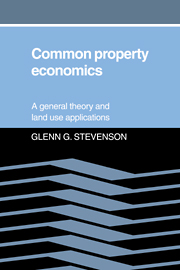Book contents
- Frontmatter
- Contents
- List of Tables and Figures
- Preface
- 1 What Is Common Property?
- 2 Open Access Theory
- 3 Common Property
- 4 The Swiss Grazing Commons
- 5 Comparisons with the English Open Field System
- 6 An Econometric Comparison of Commons and Private Grazing
- 7 The Structure and Performance of Common Property: Conclusions
- References
- Index
3 - Common Property
Published online by Cambridge University Press: 16 September 2009
- Frontmatter
- Contents
- List of Tables and Figures
- Preface
- 1 What Is Common Property?
- 2 Open Access Theory
- 3 Common Property
- 4 The Swiss Grazing Commons
- 5 Comparisons with the English Open Field System
- 6 An Econometric Comparison of Commons and Private Grazing
- 7 The Structure and Performance of Common Property: Conclusions
- References
- Index
Summary
In Chapter 2, I referred to the problem of unrestricted entry and use of a resource as the problem of open access. Frequently, others have labeled such resource use “common property.”! contend, however, that “common property” and “open access” should not be used synonymously. They are two separate resource use regimes, and the distinctions between them deserve to be understood. In this chapter, I make explicit the differences between open access and common property.
This chapter has a second major goal. Some authors in discussing open access offer private property as the best or only solution to the problem (Demsetz 1967; Cheung 1970; Ault and Rutman 1979). Private property is indeed one solution to the inefficiencies of open access. Private property is not the only or necessarily the best solution to open access problems, however. Several other ways to correct open access distortions exist, and a subset of them forms the class of common property. This chapter defends the theory that common property, once defined and distinguished from open access, may represent a solution to open access.
Definition of Common Property
I will begin by presenting a formal definition of common property, which is characterized by seven points that constitute a set of necessary and sufficient conditions for common property. The conditions are individually necessary because a resource managed under common property must meet all seven of them.
- Type
- Chapter
- Information
- Common Property EconomicsA General Theory and Land Use Applications, pp. 39 - 84Publisher: Cambridge University PressPrint publication year: 1991



